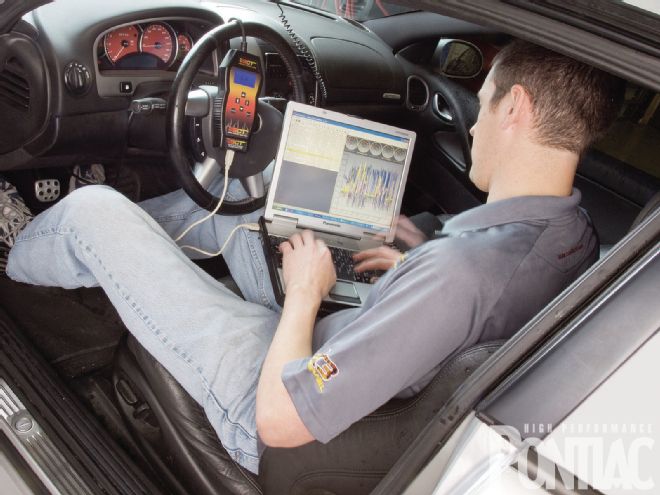
Tuning is the origin of hot rodding. Back in the day, Pontiac owners with a taste for performance would dial in their cars' air/fuel ratios and timing among other things to squeeze a few more ponies out of their engines. As aftermarket parts became more widely available, tuning was performed to compensate for the operating characteristics of the new parts, make the most of their attributes by unleashing hidden horsepower, and ensure safe engine operation.
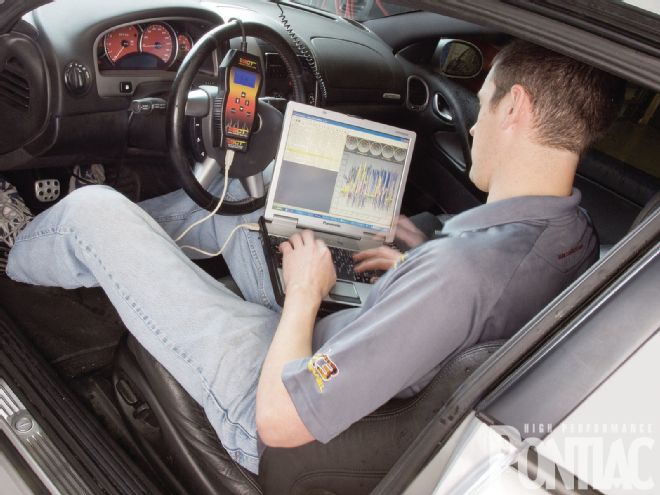 We’re back on the DynoJet to demonstrate how Ryan Krummick of SCT Performance tuned our ’05 GTO. Before making any changes, Ryan reviewed the modifications we made to the vehicle and looked over our previous and current tune files. This allows him to make a safe, conservative tune to initially load into the Pontiac.
We’re back on the DynoJet to demonstrate how Ryan Krummick of SCT Performance tuned our ’05 GTO. Before making any changes, Ryan reviewed the modifications we made to the vehicle and looked over our previous and current tune files. This allows him to make a safe, conservative tune to initially load into the Pontiac.
With the advent of electronic fuel injection, tuning became a totally different animal that today involves modifying the Electrically Erasable Programmable Read-Only Memory (EEPROM) within the vehicle's Engine Control Module (ECM) via a laptop and software and/or a handheld controller. Some fear that all this technology is too complex for the average hobbyist to tune, however, one quick look at this or any other car magazine's advertisers shows that tuners have popped up around the world, all touting they have the perfect performance file to upload to your engine's computer brain.
It wasn't really until after LS-engine ECMs arrived in '97 ('98 for the Trans Am or Formula Firebird) that EFI tuning really began to take off for the GM market. These tuners can be classified in two types—handheld and laptop.
Handheld tuners are generally used for ballpark, safe tunes with bolt-ons that only require simple yes or no answers to load a program that may moderately increase performance and retain engine safety. Many hobbyists prefer them because of their convenience, relatively cheap price, and user-friendly design. However, owners looking for the most out of their engines may be a bit disappointed by these handheld, high-performance helpers. Unless you have a pair of eyes looking into the tune and then make more in-depth adjustments, there may be power left on the table.
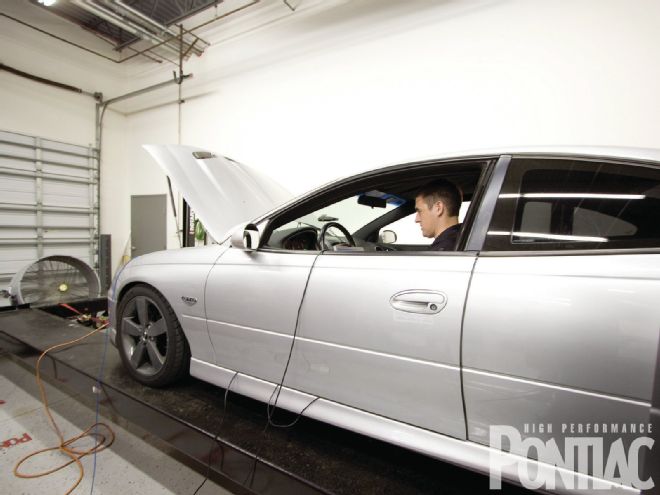 For the first series of pulls, Ryan wasn’t concerned with power. He was focused on the data being gathered by the LiveLink software as he brought the car up to 4,500 rpm.
For the first series of pulls, Ryan wasn’t concerned with power. He was focused on the data being gathered by the LiveLink software as he brought the car up to 4,500 rpm.
Windows-based software applications like LS1edit and HP Tuners answered the call for a learnable method to create more comprehensive tunes. These programs allow for more fine-tuning of the factory ECM and have quickly become the preferred method for tuning in the high-performance LS aftermarket.
About SCT
SCT Performance got its foot in the door of the tuning aftermarket in 1996 with Mustangs, but has recently ramped up its focus on GM vehicles with its latest plug-and-play tuning software, Advantage III. It's used in over 26 countries and by over 1,100 custom-tuning shops, speed-product manufacturers, and OE performance-solution providers worldwide.
SCT's X3 tuner, which uses the Advantage III software, is the latest in the company's consumer-friendly handheld tuners. It bridges the gap between traditional handhelds and the more powerful software-based tuners.
The X3 reads and reprograms the ECM and Transmission Control Module (TCM) data files, unlike many of today's popular handhelds, which only reprogram the ECM. With a wired connection to a laptop, users can download the free SCT LiveLink software and datalog—something no other competing handheld can do.
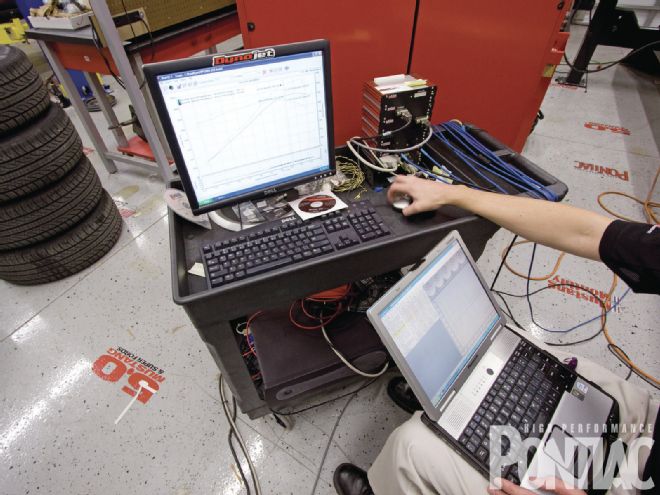 After completing a series of pulls, Ryan felt that he had enough data to review. By comparing the air/fuel commanded versus the air/fuel experienced, he could then begin to add timing and see power gains.
After completing a series of pulls, Ryan felt that he had enough data to review. By comparing the air/fuel commanded versus the air/fuel experienced, he could then begin to add timing and see power gains.
The X3 can also store three tunes. "This allows the car owner to have an economy tune, a performance tune, and a valet tune stored, if they desire," Ryan Krummick of SCT tells us.
Another feature we find promising is the device's level of connectivity to a PC. After data logging, a remote tuner can review the information and then email a new tune that can be uploaded to the ECM through the X3. This means that even in the most remote parts of the world, your Pontiac can be tuned as long as you have Internet access and a PC.
Tuning Methodology
We recently installed a TrickFlow heads-and-cam package on our LS2 in our '05 GTO and were in need of a custom tune. Ryan came from SCT's home base in Longwood, Florida, to the High Performance Pontiac Tech Center in Tampa and walked us through his tuning steps using the SCT X3 and LiveLink.
First, Ryan reviewed the hardware changes on the vehicle. A Volant cold-air intake feeds into a VMAX Motorsports-ported throttle body and a Fasterproms intake manifold. Inside the intake, air and fuel are added by a factory pump and factory 36 lb/hr injectors. This means that Ryan won't need to make changes to the fuel-flow model and injector data. TrickFlow 225 CNC heads and a 228/230-degrees duration at 0.050 cam, with 0.585/0.585 lift and a 112-degree LSA, dictate the behavior of flow into and out of the chamber, while a set of 1.875-inch American Racing stainless headers and high-flow cats, and a Corsa Sport after-cat handle the exhaust. These changes have dramatically affected the airflow model because they have made the engine more efficient. Ryan then confirmed our ignition timing requirements by determining our 11.0:1 compression ratio and 93-octane fuel.
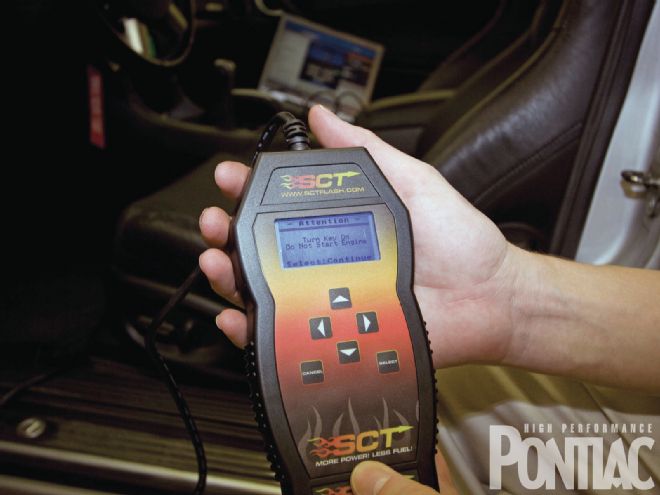 Here is the SCT X3 handheld device for our ’05 GTO. It’s used by plugging into the OBD-II port located underneath the steering wheel.
Here is the SCT X3 handheld device for our ’05 GTO. It’s used by plugging into the OBD-II port located underneath the steering wheel.
After he reviewed the data thoroughly, he made some safe air/fuel ratio commands for the initial tuning and set a conservative spark calibration. He compared the tune file with the latest stock file, and determined which changes were OK to keep and which should not be made.
Ryan lowered fan temps from the factory setting of 105-degrees Celsius to 91-degrees to keep the engine running cooler. He raised the torque limits per gear to max out at 8,000 Nm from the factory range of 115 to 380 Nm. "By setting them this high, I know the limits can't be reached," he says. "I also removed Skip-Shift, changed the diagnostic trouble code (DTC) test because of the high-flow cats, raised the idle from 800 rpm to 875 rpm, and adjusted the intake air temperature (IAT) spark table.
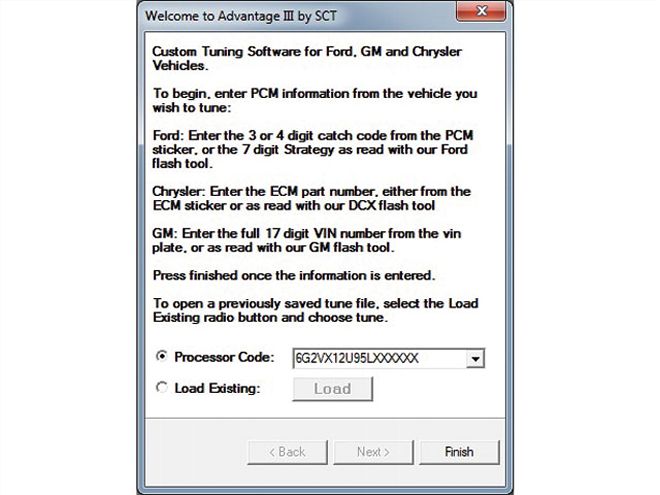 SCT's Advantage III software has a unique feature for '98-'07 GM vehicles where you can enter the full 17-digit VIN at the opening screen and the latest stock file for the vehicle is opened in the software. This allows you to tune using a stock file as the starting tune, regardless of other previous tuning attempts on the vehicle. You can also read any supported vehicle and start with the file in the vehicle as well.
SCT's Advantage III software has a unique feature for '98-'07 GM vehicles where you can enter the full 17-digit VIN at the opening screen and the latest stock file for the vehicle is opened in the software. This allows you to tune using a stock file as the starting tune, regardless of other previous tuning attempts on the vehicle. You can also read any supported vehicle and start with the file in the vehicle as well.
Data Logging
Once Ryan set the initial adjustments to ensure that our first dyno pull went off without a hitch, he opened the LiveLink software to read diagnostics data through the SCT X3. "First you'll have to set which parameters you want to log, since some are very important when tuning," he says.
Ryan listed the parameters he likes to monitor and explained them briefly to us.
RPM: It will establish a reference for all other data gathered in relation to engine speed.
Short-Term Fuel Trim (Bank 1 and 2) & Long-Term Fuel Trim (Bank 1 and 2): These are the percentage fuel corrections measured by the computer. Short-term trims are fast-acting and long-term trims are slow-acting corrections.
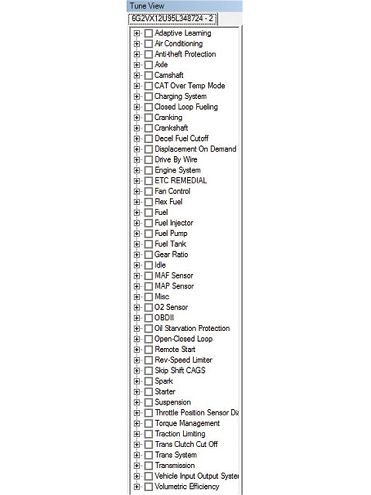 This is what you will see when you open the Advantage III software. This is the stock file for the vehicle with the categories listed on the left. Once a selection is made, the edited parameters will be displayed on the right.
This is what you will see when you open the Advantage III software. This is the stock file for the vehicle with the categories listed on the left. Once a selection is made, the edited parameters will be displayed on the right.
MAF Frequency: This is the rate at which the MAF outputs and is used by the MAF Transfer function in the ECM to determine airflow. This tells us where we are in the table to make our corrections.
Throttle Position: When analyzing the data, it's helpful to know what was going on at that time, as idle, part throttle, or wide open throttle (WOT) all have different requirements.
Commanded Air/Fuel Ratio (Equivalence Ratio): We verify this against our wideband to make sure we are getting the target air/fuel ratio.
Intake Air Temperature (IAT): The ECM uses IAT for various functions, including ignition timing. Hotter air will cause the ECM to retard the timing.
Coolant Temperature: We strive for consistent engine coolant temperature on different dyno runs to achieve better accuracy in the power run comparisons.
Airflow Calculated: This formula calculates the airflow value of the entire airflow model, not just the MAF airflow model. This is necessary to know where the ECM is looking for spark values in the spark tables.
Ignition Timing: We monitor the total timing advance the engine is seeing.
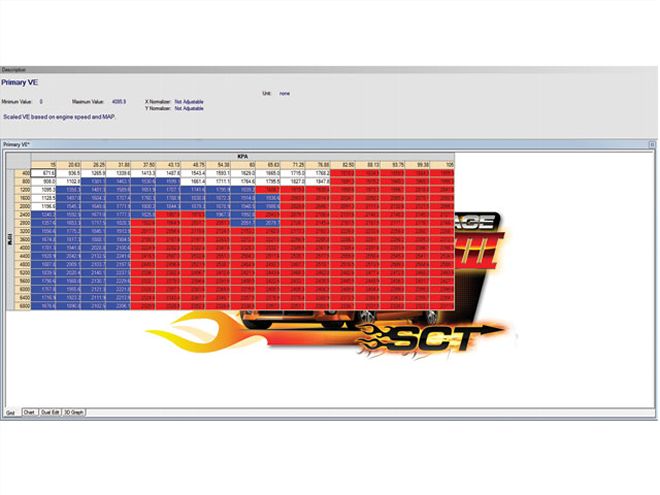 Also used in the airflow model is this table. Together with the MAF Transfer Curves (both high and low) these tables define the airflow model used by the ECM. When changing the engine combination, the VE table must be recalibrated to account for the changes in the airflow model. Note it's measured in kPa. Ryan explains, "KPa measures pressure just like psi, but the factory computer reads in kPa. At SCT, we have found there to be slight rounding when converting kPa to psi and back to command the computer, so we leave everything in kPa."
Also used in the airflow model is this table. Together with the MAF Transfer Curves (both high and low) these tables define the airflow model used by the ECM. When changing the engine combination, the VE table must be recalibrated to account for the changes in the airflow model. Note it's measured in kPa. Ryan explains, "KPa measures pressure just like psi, but the factory computer reads in kPa. At SCT, we have found there to be slight rounding when converting kPa to psi and back to command the computer, so we leave everything in kPa."
Knock Retard: We don't want any knock retard if possible, so Ryan will have to tune around it so that the knock doesn't interfere and remove timing. Simply removing knock retard is a terrible idea that could result in premature and catastrophic engine failure.
Tuning Procedure for Our GTO
Ryan explained his tuning process.
&bull Starting with a conservative calibration we start the vehicle. The short term and long term fuel trims will display how far off the airflow model is. By adjusting the VE table and MAF transfer functions to get the airflow model correct, our fuel trims will have a correction of near 1.0- or 0-percent.
&bull After adjusting the airflow model at idle, we drive the vehicle on the Dynojet for an rpm step test to sample various points in the airflow model and make our base corrections.
&bull Following these adjustments, we interpolate the changes between the sample points. Then we do more driving to verify the changes and repeat if necessary.
&bull After the idle and part-throttle airflow model is correct, we can start on the WOT pulls. For the first one, we keep a good eye on the air/fuel ratio from our wideband and do a short pull to see how things are working. After a quick pull to 4,500 rpm, we analyze the data and make changes.
• This is followed by a second pull to a higher rpm, and then more pulls to get the air-fuel ratio straightened out. For the GTO, we were commanding a safe, rich air/fuel ratio in the 12.0:1 to 13.0:1 range.
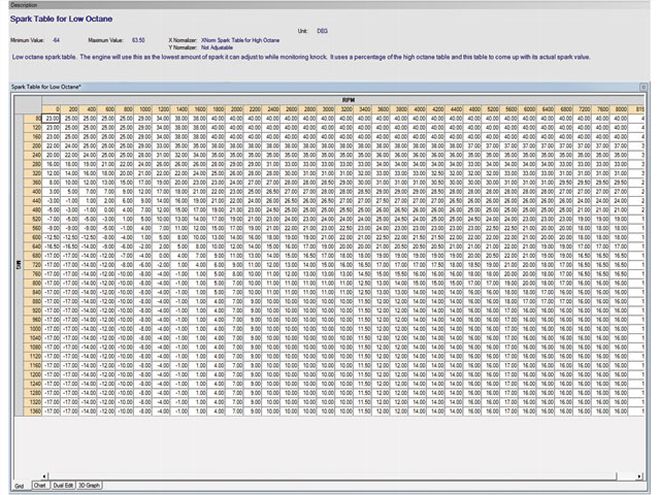 The spark tables for low octane and high octane are used for the base spark calculations.
The spark tables for low octane and high octane are used for the base spark calculations.
&bull With the timing conservative, we start to lean the car out and add timing to see where it responds to the best power and torque.
&bull As we add a degree of timing, we compare to the previous power numbers. When the increased timing stops giving us an increase in power, we drop back to the previous setting and use it as the timing for that cell. We repeat this for each rpm point in the table to safely get the most horsepower and torque that we can.
&bull After reviewing the power curve on the dyno, we drive the car on the street for several miles, gathering data, and adjusting the calibration for smooth drivability; increasing idle airflow requirements when necessary, and adjusting the rate at which the engine rpm returns to idle after coming to a stop. After all of this is completed, we continue the street testing, ensuring there are no issues and no driveability concerns."
Conclusion
After spending the day on the dyno and the street, our GTO was ready to hit the road course and, more importantly, drive home. Ultimately, Ryan installed a couple tunes to play around with and see which offered the best drivability.
He also installed a valet tune, which limits engine redline to 4,000 rpm and top speed to 40 mph. This should hinder the fun for any unauthorized drivers. The SCT system is ideal for hobbyists who want to tackle tuning themselves, as the SCT X3 and LiveLink software provide a means of tuning, code reading, and data logging in one package that can be adjusted on the fly with the X3 handheld. It's also attractive because it retains the easy use of a handheld, while providing an in-depth tune for your Pontiac, which can be returned to stock at any time. The X3 (PN 3400/3416) has an MSRP of $479. The Advantage III GM Pro Racer Package is priced at $349 for a single-user license.
Tuning and tweaking will always be around as long as gearheads are. Thanks to companies like SCT, there's no need to be afraid to tune your late-model Pontiac.